Arequipa city
The city of Arequipa is the capital of the department of the same name, located in southern Peru. It is the second most populous city in the country, only after Lima. There are many tourist attractions. Its churches, convents and museums built since colonial times stand out. It has a modern infrastructure but surrounded by an Andean landscape where the famous Misti volcano stands out. The city has an airport, hotels and restaurants that offer a good service to tourists.
All about the city of Arequipa
Explore the province of Arequipa
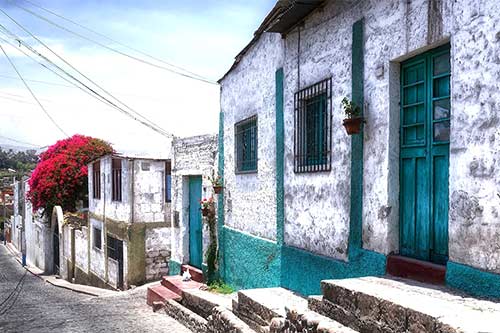
1 The San Lázaro neighborhood in Arequipa
San Lázaro is the oldest neighborhood in Arequipa. It is famous for its narrow streets, ashlar houses, history and more. It is believed that the city was founded there.
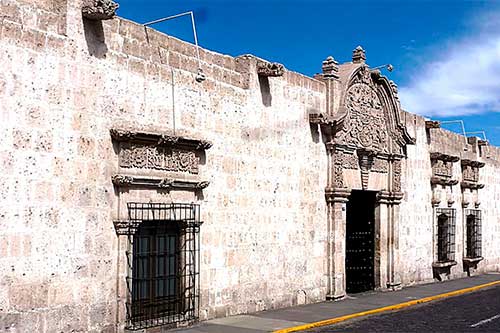
2 Moral’s house in Arequipa
The Casa del Moral is one of the most emblematic museums in the city of Arequipa. It was founded in the 18th century. It has canvases, furniture and other treasures.
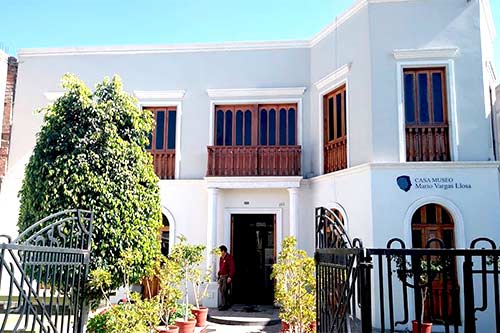
3 Mario Vargas Llosa House Museum in Arequipa
On block one of Parra street is the Mario Vargas Llosa de Arequipa house-museum. Includes holograms, videos, books and more. Admission costs 10 soles.
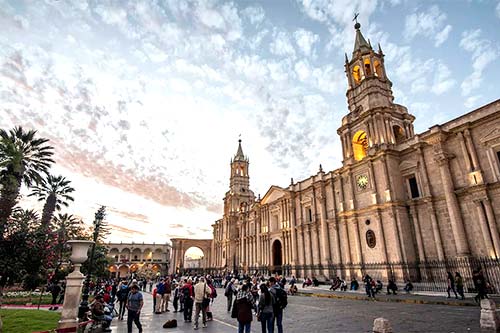
4 Arequipa Cathedral
The Cathedral of Arequipa exhibits numerous colonial treasures such as the main marble altar, the Belgian organ, Francisco Laso's canvases and much more.
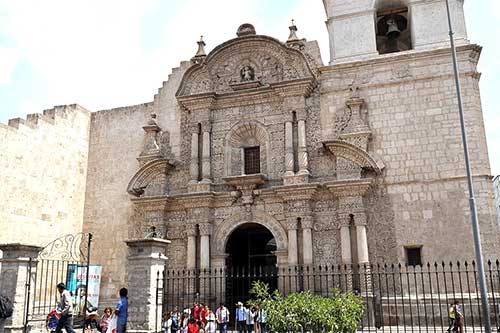
5 Church of the Society of Jesus of Arequipa
This baroque church is one of the oldest in Arequipa. Its main pulpit covered in gold sheets stands out. It is a Historical Monument of Peru.
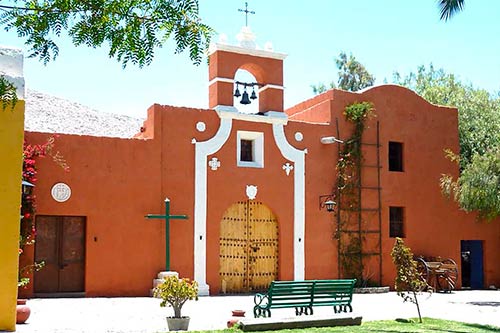
6 The mansion of the founder of Arequipa
In the countryside of Arequipa is located this museum dedicated to the historic colonial house of Don Garcí Manuel de Carbajal, the founder of the city in 1540.
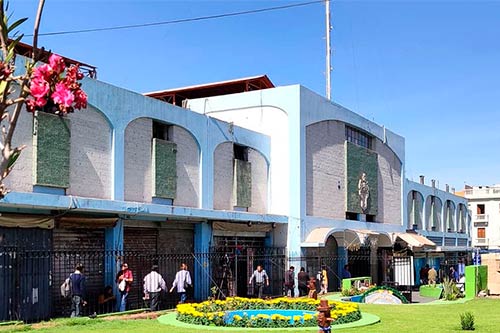
7 The San Camilo market in Arequipa
The market is Cultural Heritage of Peru and Historical Heritage of Arequipa. There was the San Camilo church that was destroyed in the earthquake of 1868
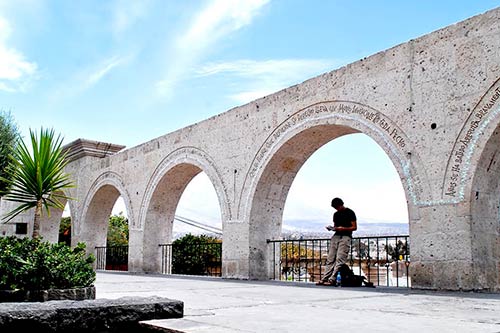
8 The Yanahuara viewpoint in Arequipa
The Yanahuara viewpoint is one of the most photographed places in Arequipa. It was built in the 19th century. Nearby is the church and plaza of Yanahuara.
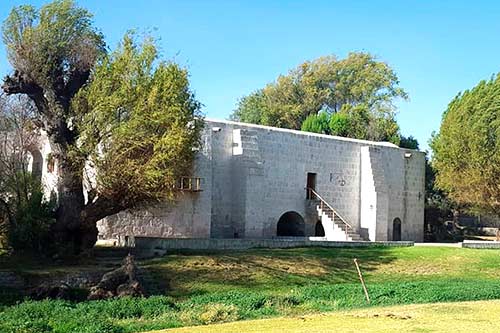
9 The mill of Sabandía
The Sabandía mill is a colonial construction where wheat and corn were ground. Today, it is considered a cultural heritage of Peru and a symbol of Arequipa.
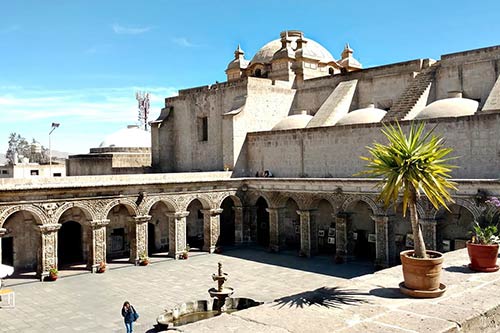
10 Santa Catalina Monastery in Arequipa
Santa Catalina is the architectural jewel of Arequipa. It was founded in 1579 during the colonial era. It has cloisters and rooms full of history and treasures.
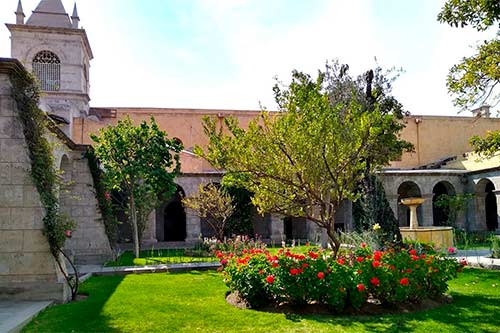
11 Santa Teresa Viceroyalty Museum of Art
The museum has 13 rooms that exhibit canvases, sculptures, murals and other treasures preserved in the more than 300 years of history of the Arequipa convent.
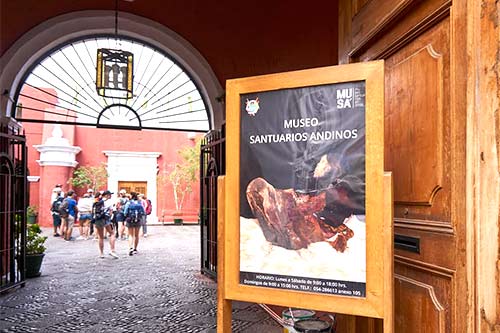
12 Andean Sanctuaries Museum of Arequipa
The museum is famous for housing the Juanita mummy, also known as La Dama de Ampato. She is about a girl sacrificed to the gods in Inca times.
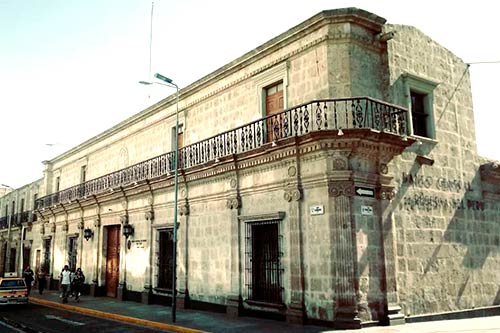
13 All about the Goyeneche palace
The site belonged to the bishop of Arequipa Juan de Goyeneche. It exhibits neoclassical architecture and works of art. There is the Central Reserve Bank of Peru.
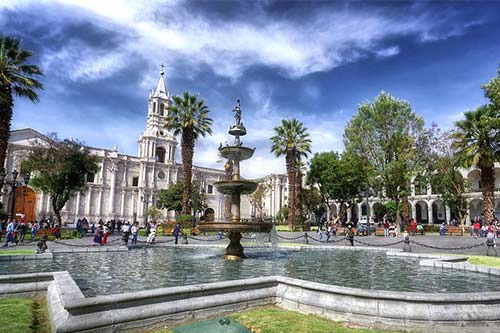
14 Arequipa Main Square
Arequipa's Plaza de Armas was born with the founding of the city in 1540. Festivities such as carnivals, anniversaries, Holy Week and more are celebrated there.
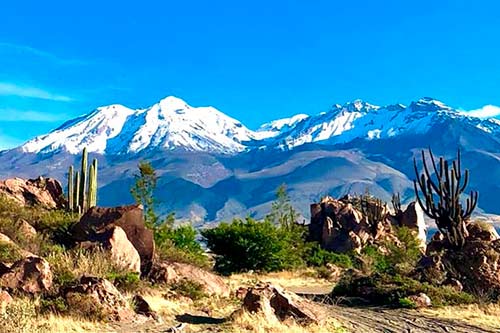
15 The snowy Chachani in Arequipa
The snowy Chachani is 45 kilometers from Arequipa. The tour lasts 2 days and is one of the most accessible. The cold and the altitude can make the walk difficult
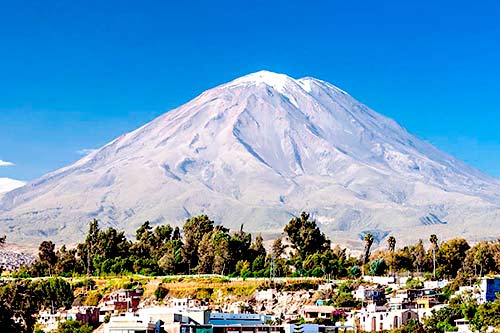
16 The Misti volcano
El Misti is the most famous volcano in Peru. It is located 18 kilometers from Arequipa. In 1998 an Inca tomb was found. The visit is with a 2-day walking tour.
Arequipa, white city
Arequipa is known as the ‘White City’ because a large part of the buildings in its ‘Historical Center’ are made of ashlar. This white colored stone has a volcanic origin due to the eruption of the Chachani volcano millions of years ago. Important architectural works of the city are made of this material, such as: the Cathedral, the church of the Company of Jesus, the temple of San Francisco, the monastery of Santa Catalina, the convent of La Recoleta, the viewpoint of Yanahuara and more. . The abundance of buildings made of this material has led to the creation of the so-called ‘Ruta del sillar’ tour.
Location
The city of Arequipa is located in southern Peru, on the western side of the Andes Mountains. It is 1012 kilometers away from the city of Lima, capital of the country. The ‘White City’ is in the Chili Valley (named after the river that runs through the city). It is surrounded by three imposing volcanoes such as: the Chachani, the Pichu Pichu and the Misti.
Altitude
The city of Arequipa is 2,335 meters above sea level (7,660 feet altitude).
Map
Tourist attractions
- The main square – The main square of the city is located in the heart of the historic center. It was built during the founding of the city in 1540. Its famous portals made of ashlar stand out. Its pool is known as the ‘Tuturutu’, a strange character who plays a trumpet and would represent a 16th century soldier.
- The neighborhood of San Lazaro – The San Lázaro neighborhood is the first to be created in the city of Arequipa. It stands out for its narrow streets, large houses and churches. The first families of Arequipa inhabited their homes. Its white facades built with ashlar stand out.
- The market of San Camillo – This popular market is one of the first to operate in the city. It has stalls selling meats, fruits, vegetables, meals, clothing, handicrafts and more. It was built in the old convent of La Buena Muerte and Church of San Camilo. It was inaugurated in 1938. In 1987 it was declared a Monumental Historical Heritage.
- The Yanahuara viewpoint – This famous viewpoint is located in the Yanahuara neighborhood. It offers a spectacular view of the three snow-capped mountains: Chachani, Pichu Pichu and Misti. It is located 2 kilometers from the Plaza de Armas, in the center of the city. It is one of the most photographed places in Arequipa.
- The mill of Sabandía – This hacienda built in the colonial era is famous for having a water mill built in 1621. It is located in the so-called countryside of the city, surrounded by trees and green areas. Its architecture is made of ashlar. Currently, the place has restaurants.
- Goyeneche’s palace – This colonial palace is one of the most beautiful in Arequipa. It belonged to the family of Juan de Goyeneche y Aguerrevere, bishop of the city. It is located a few steps from the Plaza de Armas. Inside, its French-style furniture stands out as well as its canvases from the ‘Cusqueña school’ of painting.
- Moral’s house – This hacienda-museum was the palace of the conquistador Diego Peralta Cabeza de Vaca. It was built with ashlar at the end of the 18th century. Throughout its history it was the home of various aristocratic families in the city. Inside it has colonial furniture as well as a collection of 3 thousand volumes of Hispanic literature.
- The Founder’s Mansion – As its name indicates, this colonial hacienda was built to be the palace of Garcí Manuel de Carbajal, founder of Arequipa. It is located 20 minutes by road from the city center. Its furniture, sculptures, canvases and relics from Europe several centuries ago stand out.
How to get to the city of Arequipa?
There are two ways to get to Arequipa: by bus and by plane. Most of the flights depart from the city of Lima (approximately 1 hour 20 minutes away). Likewise, there are buses that depart, along the Panamericana Sur highway, to the ‘White City’ (travel time of approximately 18 hours). There are also bus routes from the cities of Cusco, Puno and Puerto Maldonado.
Museums
- Mario Vargas Llosa House Museum – This museum, inaugurated in 2014, was the home of the Nobel Prize winner Mario Vargas Llosa, born in Arequipa in 1936. It is located on La Merced street, in the house where the writer spent his first days. It has sixteen didactic rooms that include holograms and audiovisual material from the Nobel Prize.
- Santa Teresa Viceroyalty Museum of Art – This museum is located a few steps from the Plaza de Armas, in the facilities of the monastery of Santa Teresa “Las Carmelitas”. In its 15 rooms it exhibits various treasures such as canvases, liturgical objects made of gold and silver, sculptures, furniture and more. The entrance has a cost of 20 Peruvian soles (about 6 dollars, approximately).
- Andean Sanctuaries Museum – This museum is one of the most famous in Arequipa because, among its many treasures, it exhibits the remains of a girl sacrificed in Inca times, popularly known as the ‘Juanita Mummy’. They also highlight its textiles, sculptures, ceramics and more Inca objects. It is a few steps from the Plaza de Armas. The entrance costs 15 Peruvian soles (5 dollars, approximately).
Churches
- Cathedral – This colonial church consists of impressive architecture. Its cluttered decoration consists of seventy Corinthian columns made of ashlar. Throughout its history it withstood several strong earthquakes. Inside there are treasures of gold, silver, canvases and marble furniture. The entrance has a cost of 10 Peruvian soles (3 Peruvian dollars).
- The Monastery of Santa Catalina – This religious site is one of the most famous attractions of the city. It was built in 1579, a few years after the founding of the city. It is made mainly of ashlar. It consists of 8 spaces used by the religious order of Santa Catalina and that today offer a lot of history and architectural beauty. Admission costs 40 Peruvian soles (13 dollars, approximately).
- Church of the Company of Jesus – This church belonging to the order of the Company of Jesus was built at the end of the 16th century. Its baroque architecture made of ashlar stands out. Inside they exhibit several relics with religious motives. The entrance ticket has a cost of 20 Peruvian soles (6 dollars, approximately).
Restaurants
The city of Arequipa has a great gastronomic offer, recognized as one of the best in Peru. Among its most famous dishes are the chupe de camarones, the rocoto relleno, the adobo arequipeño, the soltero (also known as ‘solterito’), the ocopa and more. Its restaurants, especially those located in the center of the city, also offer classic Peruvian dishes such as cebiche, lomo saltado, stuffed causa and many more. Among the most famous restaurants are the exclusive ‘La nueva Palomino’, ‘Chicha por Gastón Acurio’, ‘La Trattoria’ del Monasterio, the ‘Zigzag’, the ‘Sol de mayo’, the ‘Salamanto restaurant’, the ‘Benita’ and the ‘Arequipeño Tradition’.
Accommodations
The city of Arequipa has a great hotel offer. There are cheap services for backpackers to luxurious 5-star services. Most are located in the Historic Center. Some of the most recognized are: the Sonesta Hotel, the Casa Andina Premium, the Cirqa – Relais & Chateaux, the Wyndham Costa del Sol and more.
Night life
The city Arequipa offers a hectic nightlife full of joy and music. The meeting point is the Plaza de Armas, from where young people leave to enjoy the bars and clubs located around. Among the most famous nightclubs are the ‘Forum’, the Deja vu, the Jam’ Bos, the Kibosh and the Patria 209. Among the most famous bars it is worth mentioning the Museo del Pisco, the Qochamama, the Chelawasi Public House and the Peru Bar.
Clima
The city of Arequipa has a temperate and dry climate. Due to its strategic location on the western side of the Andes Mountains, just 120 kilometers from the coast, its days are sunny and pleasant while its nights are free from the cold of the mountains. Summers (from November to April) have temperatures of 11ºC. at 23ºC. During the winters (from May to October), temperatures vary from 8ºC. up to 20ºC.
History
In pre-Inca times, the Chili Valley (river that runs through the city) was inhabited by human groups dedicated to fishing, hunting and domesticating animals. Among these human groups, the first inhabitants of Arequipa, are the ‘Yarabayas’, the ‘Chimbas’ and the ‘Collaguas’ community. The chronicles say that during the incipient Inca state (in the 13th century), the ruler Mayta Cápac ordered a stop in the Chili Valley which he called “Ari-quepay” (let’s stay here) and went on to populate the place founding the towns of Yanahuara , Cayma, Tiabaya, Paucarpata, Socabaya, Characato and Chiguata. The Incas appreciated this fertile territory, among other things, because of its proximity to snow-capped peaks and important volcanoes for their religion: Misti, Pichu Pichu and Chachani.
With the arrival of the Spanish in Arequipa in the 16th century, the city became part of the nascent viceroyalty of Peru. In 1540, the lieutenant governor of the city, Don Garcí Manuel de Carvajal (by order of the conquistador Francisco Pizarro) founded the “Villa Hermosa de Nuestra Señora de la Asunción de Arequipa”. In the following years, the first large houses were built, as well as churches and even the city’s Cathedral. Because Arequipa had a mostly Spanish population, the libertarian winds did not blow strongly. What did fall hard were the earthquakes that destroyed part of the city throughout its history. For example, the earthquake of 1600, under the viceroyalty of Luis de Velasco y Castilla, which caused a lot of damage to the city.
Arequipa enjoyed an important political and social role during the Republican era. In 1827 the National University of San Agustín was created. In 1835, the ‘White City’ was the headquarters of the recently formed Peru-Bolivian Confederation. Likewise, the city was the scene of several military and civil uprisings as in 1843 and 1854. Years later, Arequipa was slowly modernizing thanks to the construction of the ‘Ferrocarril del Sur’ and the textile industry (use of wool). Currently, the city is the second most important in Peru, only behind Lima, the capital. It has more than 1 million inhabitants (2017 census). Its historic center testifies to its colonial past as well as the many difficulties it has had to go through as a result of political crises as well as successive earthquakes.
Photos
Interesting data
The inhabitants of Arequipa have a special pride in their city. That identity is manifested in their songs, gastronomy and festivities. Even, at a certain time, Arequipa passports were created (symbolically) as well as Arequipa coins called ‘El characato de oro’.
The main festivities in the city are: The festivity in honor of the Virgin of Chapi (May 1), the Immaculate Conception festivity (December 8) and the city’s anniversary (August 15).
Arequipa is known as ‘Volcanic Land’ due to its proximity to the Misti, Pichu Pichu and Chachani volcanoes. Due to this, throughout its history, the city has resisted the onslaught of strong telluric movements. Only in the last 4 centuries, the city endured 34 earthquakes. On the other hand, some 300 small earthquakes occur every month in the region, according to various investigations.
Tips
Although Arequipa is located in the Andes Mountains, the effects of altitude sickness are not so frequent in its visitors. This is because it is located at a tourist-friendly altitude. Still, drink plenty of water and adapt to your geography on the first day of your stay.
If you visit Arequipa, do not miss the opportunity to visit one of its tourist attractions located outside the city. For example, the famous Colca canyon. This impressive natural landscape is the second most visited tourist attraction in Peru, only behind Machu Picchu in Cusco.